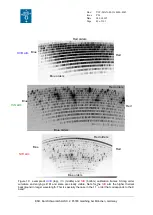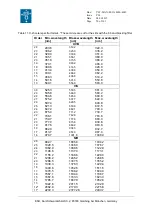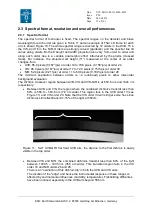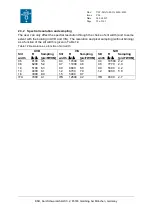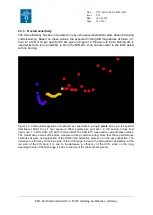
Doc:
Issue
Date
Page
VLT-MAN-ESO-14650-4942
P96
24.06.2015
39 of 161
ESO, Karl-Schwarzschild-Str. 2, 85748 Garching bei München, Germany
2.2.5 The VIS spectrograph
2.2.5.1 Slit carriage
The slit carriage of the VIS spectrograph is identical to that of the UVB but the available slits
are different. All the science observation slits are 11” high and different widths are offered
from 0.4” to 5” (see Table 7).
Table 7: VIS spectrograph slits and calibration masks
Size
Purpose
0.4”
11” slit
SCI / CAL
0.7”
11” slit
SCI / CAL
0.9”
11” slit
SCI / CAL
1.2”
11” slit
SCI / CAL
1.5”
11” slit
SCI / CAL
5.0”
11” slit
CAL
Row of 9 pinholes of 0.5”
spaced at 1.4”
CAL
0.5”
pinhole
CAL
2.2.5.2 Optical layout
The optical layout of the VIS spectrograph is very similar to that of the UVB (see Figure 7).
The collimator (corrector lens) is identical. For cross-dispersion, it uses a 49˚ Schott
SF6 prism in double pass. The main dispersion is achieved through a 99.4 grooves/mm,
54.0˚ blaze échelle grating. The off-blaze angle is 0.0˚ and the off-plane angle is 2.0˚. The
camera (3 lens groups, 1 aspherical surface) reimages the cross-dispersed spectrum at f/2.8
(plate scale 8.98”/mm) onto the detector (not tilted). Focusing is obtained by acting on the
doublet sub-unit of the camera. However, unlike the UVB arm, the back focal length
varies less than 1µm/˚C (image blur <0.004”/˚C) hence no thermal focus compensation is
needed.
2.2.5.3 Detector
The VIS detector is 2048
4096, 15µm pixel CCD from MIT/LL (type CCID-20). Like for the
UVB arm, the cryostat is attached to the camera with the last optical element acting as a
window. The operating temperature is 135K. It shares its controller with the UVB detector
and the same readout modes are available (see Table 5). Measured properties and
performances are given in Table 6. The shutter system is identical to the UVB one.

























